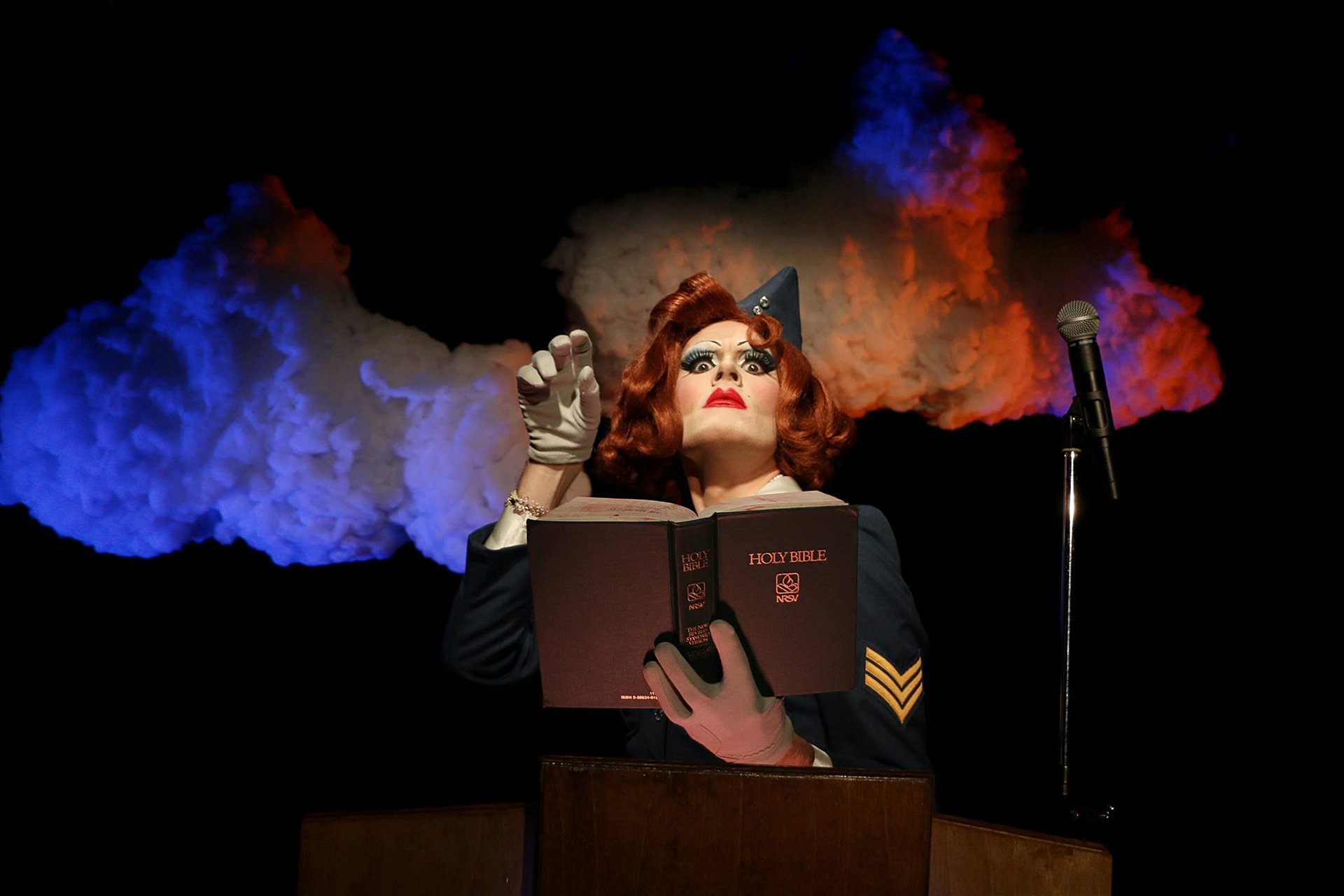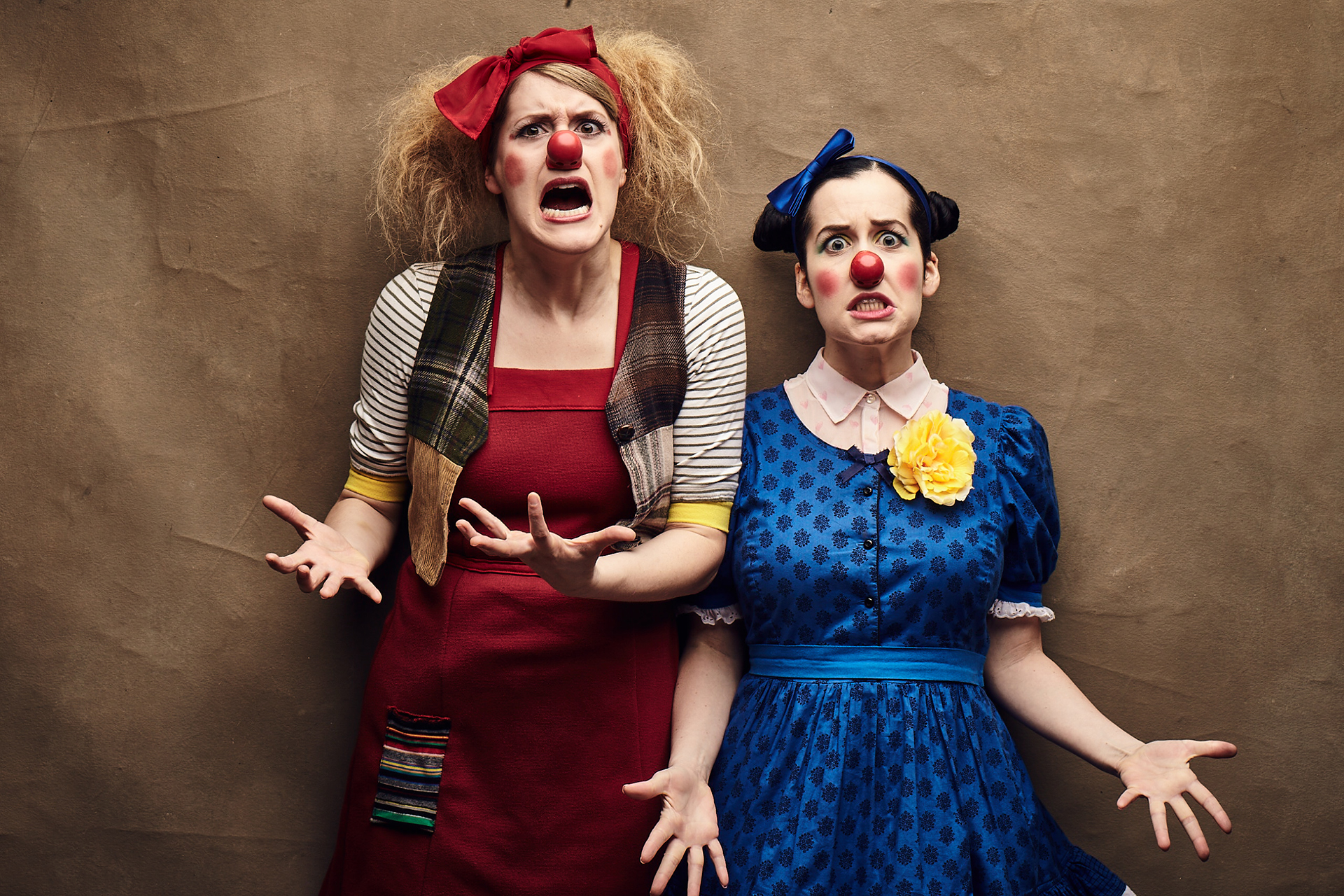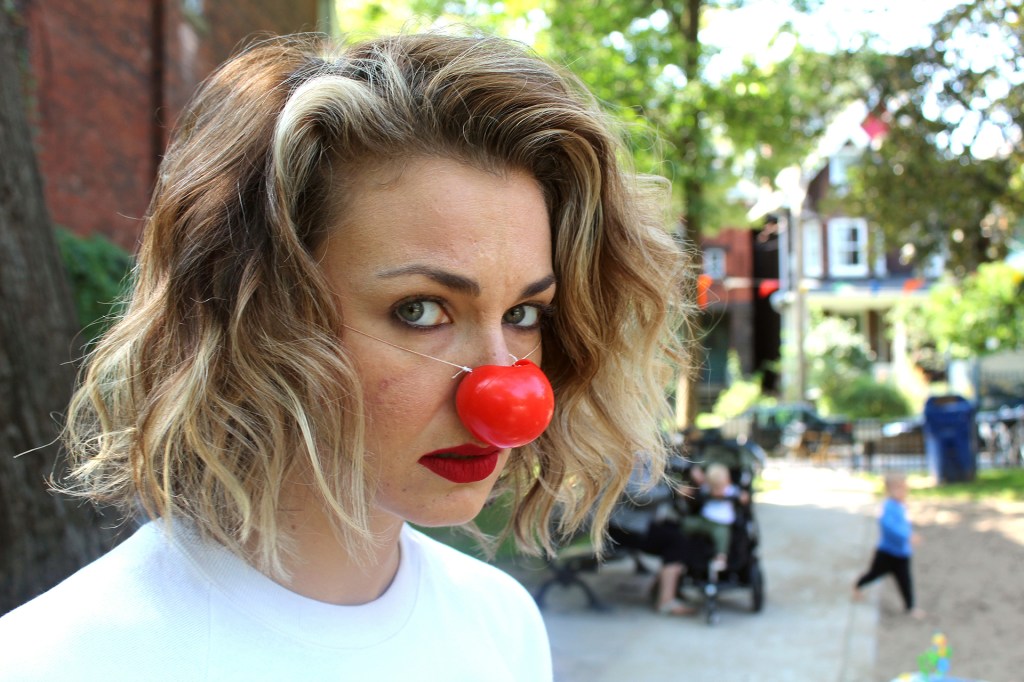I’m on the phone with Wayne Wilson, a performer with Cirque du Soleil’s VOLTA, and he seems a bit frustrated. Wilson is a clown. While performing with Cirque du Soleil, Quebec’s billion dollar global circus show, puts the performer at the top of his field, his chosen profession comes with a lot of baggage.
“I always quote the word when I say ‘clowning,’” Wilson tells me. “There is a big stigma around the word. I’ll say it the right circles and I won’t in others. In the States I say clown and people think of axe murders and rapists.”
Videos by VICE
During his run on VOLTA Wilson will beguile thousands of paying customers each night. Under the tent they’ll delight in his antics as he anchors the show with pitch perfect humour and exquisite timing. But outside of Cirque’s context being a clown is looked down upon. It’s hard for people to accept being a clown as a real job, even when being a clown is legitimately your job. For Wilson it’s easier to compare his work to comedians like Steve Carell or Stephen Colbert than try and fight against the preconceptions surrounding his profession. Even before the rampant run of murder clowns last year or the remake of It that recently hit theatres people had a general dislike for the performers. Which raises the question: why anyone would devote their life to the craft? Getting good at clown takes a lot of time and effort. Why people would put so much of themselves into something that so many people are actively afraid of?
Recently I had the chance to speak with Wilson and others about why they chose to pursue clown training, what that training actually looks like, and how people make a living by playing the fool.

Adam Lazarus, Bouffon Clown
In my mid-20s, I was in a moment of hating theatre. I was making a lot of material but no one was coming, it took up all my time, and it paid me no money. In the summer of 2002 I ran into a mentor/friend of mine on the street and told them how I was feeling. They encouraged me to go and study with Philippe Gaulier in Halifax. He was a master teacher of modern theatre. That’s all I had to go on. And with that, I plopped down $2,100 and drove across the country to study who knows what. On the first day of class, in walked a short and stout Frenchman with round glasses, a scruffy beard and a thick Parisian accent. He glared at the 30 or so students and said: Bon. We do clown. I thought: FUCK! What have I done? I don’t want to learn to be a mime in a box!
The course happened. I was terrible at clowning, but it taught me everything: pleasure, complicity, authenticity, rhythm, fixed point, true funny, not pushing too much, looking at what’s going on, and reacting. My first moment performing clown lasted seven seconds. I think the exercise was called “entertain us.” I tried, he stopped me and asked the room: if Adam was killed immediately by a bomb, would we be happier than we are right now? The class laughed and said yes. I felt like shit, but he was right. I was so boring and tried too hard. I had zero pleasure to be in front of the room. I couldn’t access my funny. And of course I wanted to be funny. But I just couldn’t get it…until I got it.
When the class turned to Bouffon—the counter mask of clown where the goal is to make fun of the audience and expose hypocrisy in humanity—I was on fire. Bouffon opened me up and gave me voice to yell and sing and mock all the things I think are crazy about the world, people, systems, relationships, religion, class, race, gender, everything. The bouffon don’t take sides. Everything is on the plate to be mocked. And so I did. During that initial school Bouffon only lasted three days. After I heard that Philippe was doing a four-month intensive in only Bouffon, so I signed up. I got rid of my apartment, sold my car, moved to Japan to make the money to go to France to study with Philippe.
In France, the first 1.5 hours of each day were physical training. Kind of circus training–back flips, falls, handstands, some singing. The rest of the day was taught by Philippe and it consisted of him saying: who’s got an idea? Students would go on the stage, present an idea, it would succeed or fail, that’s it. This happened every day for four months. The best of the four months was put into a show that ran every night for a week.
Bouffon is the fine art of satire. How do we get away with telling people that they’re assholes, have them laugh and then later realize that they were the brunt of the joke? I get people’s hang ups: There is good clown and there is A LOT of bad clown. Good clown, with or without nose, is comedy that makes you weep with laughter.

Shanda Bezic, clown/actress
I have difficulty defining what clown is even though I’ve done a whole bunch of it. My first experience performing clown myself was in theatre school. The assignment was to pick a costume you felt great *in (right?), put on the red nose, and make an entrance with a partner. After you make an entrance (one always must make an entrance) our teacher would play a song and the clowns had to respond. I hated that we couldn’t rehearse. I hated that this all felt purposeles s. But I hated even more that I was bad. I was very, very, bad. Like, when I went up, my buds would get their water bottles and use the bathroom. But at the same time there was something about it that I loved. I hated it because you couldn’t hide. The clown nose is an amplifier. It demands a truth and harmony that can only happen in the moment. Clowning made me understand that I didn’t have to be good. I had to be true. Eventually I sought out a week long clowning workshop in town and after that week, I spent two months saving up every penny I had, sold everything I owned, and moved to Chicago to study with clown at The School For Theatre Creators full time.
In many ways our curriculum was failing over and over again. All the glorious tummy turning, embarrassing sticky, awful, crummy, liberating, failing. A typical day at the clown gym would consist of four or five hours of training: acrobatics; Alexander Technique, which is a physical practice and something that changed my entire body; study the 20 Movements. Then we’d get up and play. We just kept making—all the time. Sometimes we had to re-create an oil painting with movement. Sometimes it was creating a character from a sheet of crumpled up cellophane. Some times it was a silent bank heist. We were always making.
Once a week we would have a big showing. I would go up with my group to defend our work, usually feeling like a brave dumb idiot. We’d attempt to make something funny, or beautiful, or at the very least functional. You think it’s going OK. Sometimes you know it’s not. Sometimes you can’t tell. It’s chasing the dragon. Working for that one little moment. Where everything is juste or just so. I’d think I had it then hear a small and epic Italian woman say ‘no, go back’ ‘no, go back.’ ‘Shandaaa, no. Go back’ over and over and over and over until I’d think, ‘maybe if I just kill myself then someone will laugh. That could be funny.’ But the thing is when you hit a laugh in clown it’s this transcendent moment. When you find that laugh there’s a unification between what you feel, what the space is calling for, what the audience sees and you all ride that wave together and it’s pure magic. That actual human connection through something as simple as gesture or a weird face is something I seek it out constantly in every aspect of my life. And the feeling is addictive.

Justin Miller, aka Pearle Harbour
My first experience with clown was seeing a playwright/performer named Karen Hines. She has a Bouffon character called Pochsy. While clowns look at their audiences with love, Bouffons look at their audience with hate. The style of clown is set up to show people the
worst of themselves and make them laugh at what idiots they are. Watching this character on stage kind of changed my life. Even if I didn’t quite know what the thing was yet I knew I needed to do it. I was 19.
Later I learned that the holy trinity of Buffon is charm, parody, and affliction. The invented history of the style is that it stems from the hunchbacks, dwarfs, gays, and outcasts who were outlawed from society. The majority of the time these characters were shunned from day-to-day life, but occasionally they’d be invited back into polite company to put on a show, with the caveat that if the show was bad they’d be brutally murdered. The Bouffon would put on their little piece outlining the worst of society. The performance would make fun of the masses to their face, but would be so charming that people couldn’t help but laugh. Later when the masses returned home they would recognize their awfulness and hang themselves with their neckties. That was the ultimate sign of a good Bouffon performance. Necktie hanging. In Bouffon no one is off limits: all aspects of humanity are available to everyone.
After seeing Karen perform I wrote her and asked the best way to do what she does. Eventually I was pointed to The Clown Farm on Manitoulin Island where I trained under the guidance of John Turner, one half of iconic Canadian horror clown duo Mump and Smoot. It was all revelatory.
Before I began introducing myself as I drag queen I used to introduce myself as a clown but immediately would say not like that. A lot of clowns are bad because they’re not actually being in the moment. Unlike Mimes, who are fucking liars and will tell you something is there when it’s not there, real clowns are honest. Everyone has a clown in them. Training is something I’d suggest to anyone, regardless of if they’re a comedian or actor. It can teach you about the vastness of your own humanity and the power we are all capable of as listeners, performers, and humans.

Amy Lee, aka Jasp the clown
The image of clowns was in my life as long as I can remember. Growing up my room was always decorated with clowns. I had a clown bedspread. There was a clown lamp in my room. People would give me clown toys as gifts and I began actively collecting them. I didn’t really think about why but I did know that they made me happy. That shifted in fourth grade. I attended a friend’s birthday party that happened to be on Halloween. I walked into the party during the scene from It where Georgie was being lured into the sewer by Pennywise. I ran out of the room screaming and traumatized. It put me off clowns for a while.
I didn’t actively seek out clowning. I was approached in theatre school by Byron Laviolette who had studied Canadian Clown. He had seen Heather Marie Annis, my clowning partner, and I perform and asked if we would be interested in trying clown. We said yes but had no idea what we were getting into. In some ways it seems like clown sort of chose me (or us) rather than me choosing it.
Our initial classes were with Peter Jarvis, who is better known as Silver Elvis, a human statue who performs outside of the Eaton Center. The first thing we ever did in clown training was something called the integrator. We’d lie down on the ground and rotate our arms over our body. One rotation would take about an hour and during that time you release all of these feelings, going through the full gamut of emotions with the movements. It was one of the most intense things I’ve ever done. It is hard to explain if you’ve never done it yourself, but Pochinko clowning taps into your impulses and intuition on a non-intellectual level.

Wayne Wilson, Clown with VOLTA by Cirque du Soleil
I went to a performing art high school in Houston. I had always been into physical theatre and physical comedy. Mask Work. Mime. Commedia Dell’arte. One of my mentors was a clown in the city and would coach me through various performances. We worked together on this presidential scholarship for the arts competition and became very close. Eventually he got hired by Cirque and needed a partner. I was in second year at Guthrie in Minneapolis. I quit school and I went to Cirque. I was 19. Cirque was the first time I ever dipped my toes into creating my own characters. It was the first time I didn’t have a script to follow. We developed things doing animations and movements. My life just kind of progressed from there.
My first big show…the training was really tough. We worked ten hours a day. Six days a week. We were stuck in a room doing different walks. Finding Silhouettes. Making different dynamics with the other clowns in the show. In rehearsal it’s just this massive undertaking. Strain on your body and massive exhaustion. For a clown that’s no so bad though. The exhaustion makes you vulnerable. That’s when the best shows happen.
In those rooms it was ten hours of just failing. I’m a professional failure and I’m proud to say it. I don’t have to dance well but I’m a great bad dancer. I don’t sing well but I’m a great bad singer. I believe I’m beautiful in my failure. Bombing is the only way I’ve learned to grow. When something works, that’s the addiction.
Clown can carry a negative connotation. I’m from Texas and there are other things in Texas I don’t talk about, let alone being a clown. Usually people think or birthday parties clowns or the Stephen King film. But in the circus it’s one the most regarded positions to have. It depends on who I’m talking to and how they feel about art if I’ll bring it up at all. My father worked at an aluminum can factory for thirty years. So if he goes to work and says my boy is a clown they don’t always understand. Usually in those instances I’ll say I’m a physical comedian or comic. You can call it what you want though, as long as people are laughing that’s all that really matters to me.
These responses have been edited for length.
Graham Isador is a fool but not a clown. Follow him on Twitter.
More
From VICE
-

Collage by VICE -

Screenshot: Xbox Game Studios -

-

Screenshot: Sony Interactive Entertainment
